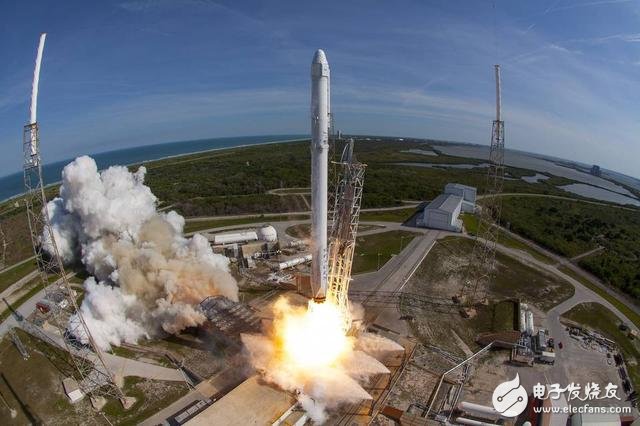According to foreign media reports, the preliminary investigation report of the US Government Accountability Office showed that the SpaceX company's Falcon 9 rocket propulsion system parts have systematic cracking failure, which will affect the company's future manned launch plan.
Congressional investigators questioned the future manned launch of Space Exploration Technologies. According to government officials and industry insiders who know the details, the rocket's important propulsion system parts continue to crack.
A preliminary investigation by the Government Accountability Office found that there were a series of failures in the turbine blades that injected fuel into the rocket engine. The final report is expected to be released next week, and the report is the first to publicly identify one of the most serious failures of the Falcon 9 rocket.
According to industry insiders, parts that are prone to cracking are considered to be a huge potential threat to rocket safety launches, and many require redesigning the Falcon 9 turbo pump. NASA warned SpaceX that such cracking would pose an unacceptable risk to manned flights.
A SpaceX spokesperson said "our engine is sufficient to deal with these cracking conditions", but we are "modifying the design to avoid cracking problems." This unprocessed change will complete the qualification verification of the manned spacecraft in the final design of the Falcon 9 "cooperating with NASA," he added.

Entrepreneur Elon Musk's company, SpaceX, a limited shareholder, has sent several dangerous signals. It was supposed to be the first unmanned launch from the newly renovated launch site of Cape Canaveral, Florida, at least two weeks late, and the ground equipment test was postponed. Now, SpaceX's earlier launch at the Kennedy Space Center's 39A launch pad is not expected to be earlier than mid-February. The launch pad is the historical site for launching NASA's Apollo mission to the moon.
Together, the challenges of these technologies and schedules have forced SpaceX, based in Southern California, to revisit the vision of accelerated launch speeds. This year, the company's goal is to launch more than eight rockets last year to fulfill its commitment to NASA and to reduce the excessive accumulation of delayed business plans.
SpaceX's internal planning envisions increasing total emissions, one per week for about a decade, including at least one of its most powerful Falcon heavy boosters per year. The development of the Falcon heavy rocket has lagged behind the schedule for several years, but SpaceX wants to achieve its first flight in the second half of this year.
A few months ago, even a few years ago, the industry had already known the problem of blade cracking in the Falcon 9 design. But until September 2016, the cracking in the test continued to occur, and NASA's acting director, Robert Lightfoot, confirmed the incident in an interview with Wall Street Journal this week.
NASA officials briefly understood the key findings of the preliminary investigation by the Government Accountability Office.
Mr. Letterford said, “We talked to SpaceX about turbomachinery†and added that he thinks “we know how to solve this problem.†In the interview, Mr. Letterford said he didn’t know if the solution might need to spend more. Time to change a larger turbo pump.
The final report of the Government Accountability Office will delve into the delays in the launch of the SpaceX manned space capsule and the conclusions of Boeing’s response to other external experts. Investigators from the Government Accountability Office said that both companies may miss the deadline for starting to routinely carry astronauts to the International Space Station in 2018.
According to industry insiders familiar with the draft report, the Government Accountability Office also pointed out that frequent revisions to the Falcon 9 design may delay NASA's certification of its boosters.
For Boeing, the Government Accountability Office investigators asked about the test status of the reliability of the parachute system, as the parachute system helped to safely land the manned spacecraft return.
Industry insiders said that the Government Accountability Office also determined that it is more difficult for the two companies to complete NASA's statistical target, that is, no more than one astronaut death in 270 flights.
The turbine problem seems to have nothing to do with the recent SpaceX launch delay.
A few days ago, the company announced that it would temporarily cancel the planned launch of EchoStar Corp.'s commercial communications satellite. At the same time, SpaceX does not have a federal launch license, and the company can only be launched on the 39A launch site on February 3rd.
SpaceX said the change "provides extra time for ground system detection" but does not expand.
The spokesperson said that "we have been in close contact with the Federal Aviation Administration for six months to obtain a launch permit for the 39A launch pad" and are expected to be permitted.
The Federal Aviation Administration, which is responsible for launching licenses, said earlier this week that it "closely contacted SpaceX" to determine that the company's application "satisfies all applicable regulations related to public health and safety."
SpaceX decided to cancel the launch of EchoStar Corp.'s commercial communications satellite in mid-February and complete NASA's space mission to the International Space Station. While some NASA officials initially wanted to confirm that the new launch pad's equipment and performance met commercial launch standards, it seems that the organization is more eager to replenish the orbital space station's experiments.
Disposable Eletronic Cigarette
Disposable eletronic cigarettes,vape 3300 puffs rechargeable,vape 3300 puffs disposable
Shenzhen Aierbaita Technology Co., Ltd. , https://www.aierbaitavape.com